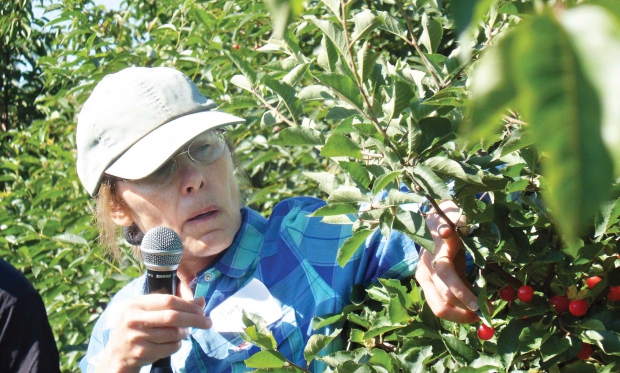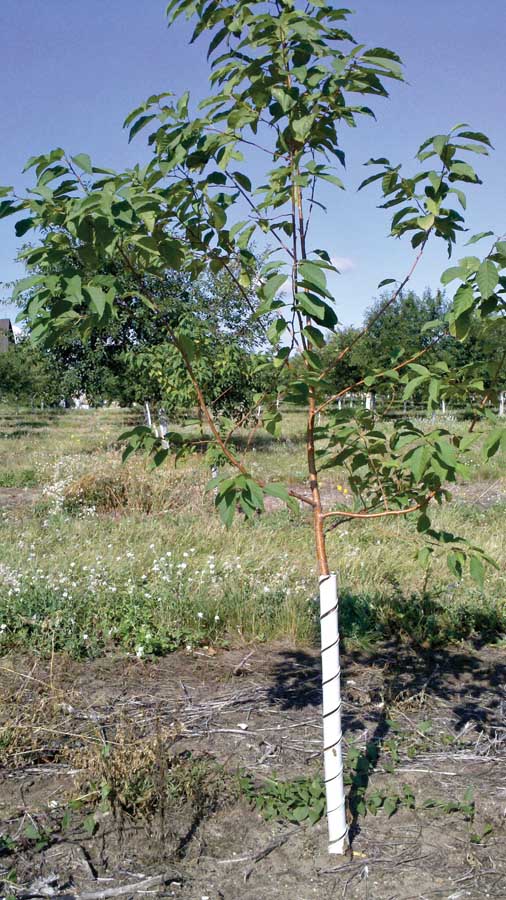
Amy Iezzoni is incorporating the chokecherry Prunus maackii in her breeding work and search for disease-resistant varieties and rootstocks. (Richard Lehnert/Good Fruit Grower)
After years of quietly accepting Armillaria as a disease that not only kills trees but passes a death sentence on stone fruit sites that become infected, there is new hope that such sites may one day be replanted with resistant trees.
That springs from the discovery that the Amur chokecherry, Prunus maackii, a wild cherry species from the region along the Siberian and Manchurian border, shows a high level of resistance to Armillaria. Its resistance comes from plant-produced compounds with fungicidal activity that prevent the disease from developing.
The resistance was discovered by plant pathologist Dr. Ray Hammerschmidt at Michigan State University. His special area of research is in induced resistance; he studies plants that secrete compounds that fend off pests that attack them.
He began working with Armillaria more than 20 years ago and has been screening Prunus species looking for resistance. He developed a relatively rapid assay based on the observation that Armillaria initially colonizes tissues between the periderm and the wood.
Hammerschmidt concluded that P. maackii carries a gene or genes that produce fungicidal compounds.
“The outer bark of P. maackii was determined to contain compounds that are antifungal,” he said.

Ray Hammerschmidt
It’s not like typical single-gene resistance, as in scab resistance in apples, but is more of an entire pathway.
“The compounds may also serve as good biochemical markers for resistance screening of other species and hybrids from crosses,” Hammerschmidt said.
The discovery is likely to pique the interest of peach, cherry, and plum breeders across the United States, and it quickly led to a new collaboration between Hammerschmidt and Dr. Amy Iezzoni, the tart cherry breeder at Michigan State University.
She began immediately to address some questions:
First, is a Prunus maackii graft compatible with the tart cherry variety Montmorency, which dominates that industry? If it is, can it be used directly as a rootstock without any further development being needed?
Second, can P. maackii be used in her breeding program to move those resistance genes into suitable rootstocks that existing varieties can be grafted onto?
Third, might that resistance already be in some of the seedlings she is working with in her breeding program? She has made many crosses with tart cherry and has some hybrids, both rootstocks and scions, ready for screening.
Iezzoni found that a breeder from Russia, Gennady Eremin, who bred the Krymsk rootstocks now used in cherries, had used P. maackii in his breeding program. Krymsk 6 is a quarter P. maackii, but it is not Armillaria-resistant, she said. Scientists in Russia assured Iezzoni that P. maackii had been tested and found graft-compatible with tart cherries.
Ornamental stone fruit

Prunus maackii growing in an orchard heavily infected with Armillaria. The tree was planted in October 2013, and the photo was taken August 2014. (Courtesy Amy Iezzoni)
Prunus maackii is an ornamental stone fruit that is used in the landscape nursery trade. Iezzoni has contracted with Sierra Gold, a California nursery, to grow out P. maackii as a rootstock and to bud these liners this spring with Montmorency tart cherry and one sweet cherry.
She will plant these trees at several locations in Michigan and evaluate Armillaria resistance, productivity, and other horticultural characteristics.
Last year, in collaboration with Dr. Nikki Rothwell at the Northwest Michigan Horticulture Research Station, she planted 12 Prunus maackii seedlings on the Old Mission Peninsula north of Traverse City, on a site known to be infected with Armillaria, to begin studies to confirm “field resistance.” After one year, the trees were still healthy, but Iezzoni wants to observe them for at least four more years.
A key problem with P. maackii may be its lack of precocity. It’s productivity as a rootstock for cherries is not known, and Iezzoni plans to evaluate both of these factors as well as graft compatibility.
“We’re at the very infancy of this, but we will pursue it quite aggressively,” she said. As coordinator of the RosBREED project, which under a new grant plans to address disease resistance as a priority, she believes other breeders, especially peach breeders, will find this new discovery of keen interest.
“There is a long history of not much happening to help combat this disease,” she said. “But it is a problem in peaches as well as cherries, and is a terrible problem on almonds.” Peach growers with Armillaria-infested sites may find the rootstock Sharpe provides some level of protection.
Serious disease
How serious is Armillaria in tart cherries?
Jim Nugent, a Traverse City area grower and former coordinator of the Northwest Michigan Horticulture Experiment Station, says it’s a major problem. “I know many cherry sites that have been converted to houses because of it,” he said.
Iezzoni will find no shortage of Michigan sites on which to test her trees, he added.
Once found in a stone fruit site, there is no way to eliminate it, he said. Fumigation is not effective. The fungus survives on infected wood and roots in the soil for an unknown amount of years—at least 18, Nugent found from personal experience. It is found on sandy sites mostly, but the disease is widespread in nature, attacking hardwoods, especially oak, giving it the common name of oak root disease. It attacks conifer trees as well.
While the disease releases spores by sprouting mushrooms in the fall, the major means of spreading is through rhizomorphs, often called shoestrings because of their appearance. It doesn’t move rapidly, but it is relentless and long-lived.
In fact, in 1992, an organism discovered in Michigan’s Upper Peninsula was said to be the largest living “creature” in the world and possibly the oldest. The organism, all genetically identical, covered 37 acres and was estimated to be 1,500 years old. That organism was Armillaria.
That record stood only a short time until another was found in southwest Washington State that covered 1,500 acres. But in 1998, a still larger one was found in the Blue Mountains of Oregon that covered 2,400 acres and was estimated to be at least 2,400 years old, and perhaps as much as 8,650 years old.
“It’s like discovering terminal cancer,” Nugent said. “It’s a death sentence for a stone fruit site.”
If P. maackii turns out to be graft-compatible and a suitable rootstock, “that would be tremendously lucky,” he added.
But if not, the discovery of a Prunus species that is resistant provides a base for breeders—and possibly genetic engineers—to build on. •






Leave A Comment